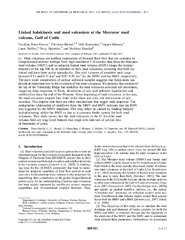| dc.contributor.advisor | Mienert, Jürgen | |
| dc.contributor.author | Perez-Garcia, Carolina | |
| dc.date.accessioned | 2012-12-03T12:13:18Z | |
| dc.date.available | 2012-12-03T12:13:18Z | |
| dc.date.issued | 2012-09-13 | |
| dc.description.doctoraltype | ph.d. | en |
| dc.description.popularabstract | Understanding how mud volcanoes and cold seep sites on continental margins function and how they are distributed is important for quantifying their contribution to the global biogeochemical carbon cycle and for assessing their role in climate change.
Mud volcanoes and cold seeps have been an important target for the Hot spots Ecosystem Research on the Margins of European Seas (HERMES) project due to their control on deep sea biota and on carbon and sulphur turnovers at European margins. A challenging issue for the HERMES research community was to understand the temporal variability of fluid flow activity at such seep sites. A comprehensive understanding of fluid flow related systems is only possible through a multidisciplinary integration of studies integrating shallow and deep processes. Hence there is a need for integration of geological, geophysical and geochemical information studying different aspects of fluid flow and sediment mobilization. So far, understanding of marine mud volcanoes has been largely hampered by insufficient seismic imaging capabilities and insufficiently ‐constrained eruption histories.
As a contribution to the comprehensive and interdisciplinary objective of the HERMES project, this study aims to improve the current understanding of complex plumbing systems of submarine mud volcanoes, their trigger mechanisms and their periodic activity. The thesis focuses on two targeted areas by the HERMES research community: a) the Håkon Mosby mud volcano and the Sørvestsnaget basin salt diapir, both located at the SW Barents Sea margin and b) the Mercator mud volcano located at the western Moroccan margin (Gulf of Cadiz). The two tectonically different geological settings were chosen to study triggering mechanisms for sediment mobilization and plumbing systems controlled by a) pressure and differential density between sedimentary layers and b) external factors such as the tectonic regime and sediment deposition/erosion.
The main objective of this study is to understand and constrain the geological processes that control the evolution of sediment mobilisation structures at two locations including mud volcanoes and salt diapirs (or both). For this purpose, the first two papers are dedicated to the 3D seismic analysis of the internal structure of mud volcanoes and their plumbing systems that includes an analysis of their feeder conduits, mud extrusion (type, magnitude and periodicity) and trigger, focused on mass-wasting events and salt diapirism. A third paper is dedicated to the study of the dynamics of a salt diapir (as a structure that results from sediment mobilisation) by using the seismic character to infer kinematic phases and related morphology. In addition, geothermal and geochemical data support seismic observations in papers I and II, respectively. The last paper focuses on the origin of fluids of the Mercator mud volcano, on which I collaborate providing geophysical data to geochemical data and interpretations. | en |
| dc.description.sponsorship | EU-HERMES(GOCE‐CT‐2005‐511234‐1)project
NFR project PETROMAKS(169514/530) | en |
| dc.description | Papers 1, 3 and 4 of this thesis are not available in Munin: <br/>1. Perez-Garcia C., Feseker T., Mienert J. and Berndt C.: 'The Håkon Mosby Mud Volcano : 330 000 years of focused fluid flow activity at the SW Barents Sea slope', Marine Geology (2009), vol.262:105-115. Available at <a href=http://dx.doi.org/10.1016/j.margeo.2009.03.022>http://dx.doi.org/10.1016/j.margeo.2009.03.022</a> <br/>3. Haffert L., Haeckel M., V. Liebetrau, C. Berndt, M. Nuzzo, A. Reitz, F. Scholz, J. Schönfeld, C. Perez-Garcia and S.M. Weise: 'Fluid evolution and authigenic mineral paragenesis related to salt diapirism : the Mercator mud volcano in the Gulf of Cadiz' (manuscript). <br/>4. Perez-Garcia, C., Safronova, P., Mienert, J., Berndt, C. and Andreassen, K.: 'Extensional rise and fall
of a salt diapir in the Sørvestsnaget Basin, SW Barents Sea' (manuscript) | en |
| dc.identifier.isbn | 978-82-8236-068-5 | |
| dc.identifier.isbn | 978-82-8236-069-2 | |
| dc.identifier.uri | https://hdl.handle.net/10037/4648 | |
| dc.identifier.urn | URN:NBN:no-uit_munin_4362 | |
| dc.language.iso | eng | en |
| dc.publisher | Universitetet i Tromsø | en |
| dc.publisher | University of Tromsø | en |
| dc.rights.accessRights | openAccess | |
| dc.rights.holder | Copyright 2012 The Author(s) | |
| dc.rights.uri | https://creativecommons.org/licenses/by-nc-sa/3.0 | en_US |
| dc.rights | Attribution-NonCommercial-ShareAlike 3.0 Unported (CC BY-NC-SA 3.0) | en_US |
| dc.subject | VDP::Mathematics and natural science: 400::Geosciences: 450::Marine geology: 466 | en |
| dc.subject | VDP::Matematikk og Naturvitenskap: 400::Geofag: 450::Marin geologi: 466 | en |
| dc.title | A multidisciplinary subsurface analysis of mud volcanoes and salt diapirs in European Seas | en |
| dc.type | Doctoral thesis | en |
| dc.type | Doktorgradsavhandling | en |


 English
English norsk
norsk

